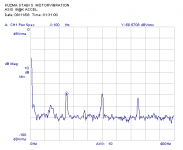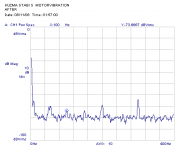\edit: I see what you might mean, have the z-axis as time on a slow sweep so that a 3D record of the pitch stability forms? Interesting !
Yes, not sure if it would have any interesting information.
Jan,
Some of us here in the States actually can do that dimensional conversion in our heads! I work with both systems all the time, it is second nature at this point. Just have to remember 25.4 to 1 cc and mm are so common today, everything is marked in both English and metric measures. Now when cooking things here are still mostly in cups, quarts, teaspoons and such, that just seems to persist.
Some of us here in the States actually can do that dimensional conversion in our heads! I work with both systems all the time, it is second nature at this point. Just have to remember 25.4 to 1 cc and mm are so common today, everything is marked in both English and metric measures. Now when cooking things here are still mostly in cups, quarts, teaspoons and such, that just seems to persist.
Now that we are on record players again. Most AC motors of belt-driven players are not optimal. The standard Airpax motor uses a capacitor to generate the 90 degr phase shifted voltage for the quadrature coil. However, if that cap is not exactly the right value, the phase shift is not exactly 90 degr and the motor vibrates more than necessary.
If you measure the sidebands due to the vibrations and finetune the cap value, the vibrations decrease.See attached plots. In this particular case, the cap was 0.22uF (or 22nF, don't remember exactly) and we had to add about 5% to get the vibration minimum.
Jan
If you measure the sidebands due to the vibrations and finetune the cap value, the vibrations decrease.See attached plots. In this particular case, the cap was 0.22uF (or 22nF, don't remember exactly) and we had to add about 5% to get the vibration minimum.
Jan
Attachments
Last edited:
As a name drop that is a horrendous bag of fail. Firstly its Lucasfilm (one word and has been since I was in shorts). Secondly the place to go for sound is the Skywalker ranch, where skywalker sound is based.
So I doubt Waly will be tweaked at all.
I dont claim to be a great speller of prose......... and yes as for the details...I was at the Skywalke ranch. Now Waly can be suitably tweeked.
THx for those important, clarifying details.
-RNM
That's a pretty decent article.
The earliest "cooled termination" approach is I believe from W. S. Percival in Wireless Engineering, Vol. 16, 237, 1939, followed by a slightly more scholarly discussion in Strutt and van der Ziel, Physica, Vol. 9, 513, 1942. It is also discussed in van der Ziel, Noise, Prentice-Hall, 1954, pp. 281-283.
The cooled termination approach amounts to a negligible noise reduction for MC cartridges, given their low inductance. Applied to the Cordell approach to realizing (most or all) of the 75us tau rolloff by a stiffish loading of a MM cartridge, it can assist that a good deal---but you have to know the cartridge inductance accurately.
As to still-better topologies, certainly lower noise and large overload margins can be pursued, but I'm not ready to discuss these at the moment.
Brad
The author ignores the ESR of the coil on those noise plots, IMO that's why the noise improvement for active termination is less than expected.
I thought you discussed rumble filter and I mentioned the link in this contest
Here is a good reading:
Audible Effects of Mechanical
Resonances in Turntables
Last edited:
Dimitri,I was just reading up on you rumble HP filter. Most of my measurements show a 0.55Hz speed modulation from the record eccentricity and/or the spindle being too small diameter. I thought that this would cause an FM modulation on the signal rather than an AM modulation. So I wonder whether a HP would help with this?
Jan
Jan, I agree, rumble filter wouldn't help here. I'm considering rumble filter only to prevent acoustic feedback.
Acoustic breakthrough
record players - 1
Acoustic breakthrough
record players - 2
And you can hear this frequency modulation readily enough, even when it is very small, if you have good pitch sensitivity. One of the great things about the vinyl revival is the care now taken by some to minimize the eccentricity. There are some awfully good remastered vinyls out there now. It will never be a perfect medium, and practically speaking will be limited to two-channel, but we're finally getting some product that is about as good as it can get.Yes, tiny offset is all it takes, If center hole is off, or doesn't fit snug to the platter spindle then eccentricity effects occur.
I once bought a two-LP set of Messiaen's From the Canyons to the Stars. Both LPs had outrageously off-center holes. I bought a second set---same thing! I wound up enlarging the holes with a tapered reamer, manually centering them on the turntable, and recording them to tape.
I speculated that whoever was in charge of the process, if they did any audition at all, thought that it was just the way the music was supposed to sound
It would be so easy to generate precise quadrature drive.Now that we are on record players again. Most AC motors of belt-driven players are not optimal. The standard Airpax motor uses a capacitor to generate the 90 degr phase shifted voltage for the quadrature coil. However, if that cap is not exactly the right value, the phase shift is not exactly 90 degr and the motor vibrates more than necessary.
If you measure the sidebands due to the vibrations and finetune the cap value, the vibrations decrease.See attached plots. In this particular case, the cap was 0.22uF (or 22nF, don't remember exactly) and we had to add about 5% to get the vibration minimum.
Jan
On each of the two turntables I have on loan from Don North, the drive signal is crystal-controlled, which is well and good. But for the two speeds of 33.3 and 45 rpm, Heybrook doesn't bother to switch the phase-shift capacitor! In addition the off-line power amp (non-isolated) is on constantly, with the output coupling capacitor failing (each was DOA when I received it), the crystals are switched by a rotary switch with long lines going to the crystals and associated oscillator---so there are periodically dry-contact problems. Oh, and a bunch of other defects. But one it is spinning (sometimes requiring some manual help as the starting torque is marginal) it plays LPs quite well. At least the platter is fairly high-mass.
Group-delay compensation with FIR ---- Conference on DSP Sept.2014;
http://www.dafx14.fau.de/papers/dafx14_stephan_herzog_low_frequency_group_delay.pdf
It just keeps getting better ---
THx-RNMarsh
http://www.dafx14.fau.de/papers/dafx14_stephan_herzog_low_frequency_group_delay.pdf
It just keeps getting better ---
THx-RNMarsh
Last edited:
You know---in the midst of all of this GD concern, have we not heard some surprisingly attractive bass produced by tube amps? I think Scott W. mentioned this a few thousand posts back, and when someone gave me a mid-fi tube amp (a blown fuse was all that was wrong) I found it remarkably pleasant listening. I'm almost afraid to measure the actual response into the speaker loads 
I didn't leave it in the system since (a) too much heat and (b) I couldn't leave well-enough alone, and noticed how drastic the effect of line voltage variations was, so set out to regulate the screens. Of course it sits in a corner now waiting for attention.
I didn't leave it in the system since (a) too much heat and (b) I couldn't leave well-enough alone, and noticed how drastic the effect of line voltage variations was, so set out to regulate the screens. Of course it sits in a corner now waiting for attention.
How could we improve on this?
Subsonic / Rumble Filter for Phono preamps and Sub-Woofers
THx-RNMarsh
Hmmm, the Ultimate Rumble Filter
http://www.diyaudio.com/forums/anal...ore-effective-than-just-high-pass-filter.html
Of course you can.I just started reading that paper but I just can't imagine how even if you could look ahead change the physics of the speaker in a box. The air volume behind the speaker has to be excited by the drive, there is no way around that.
Let takes as an example a speaker with the traditional group delay with a time descending from low frequencies to high frequencies. You can cut the bandwidth in several little slices and apply at each of them a delay. Then sum them back.
The question is: for which benefit ? I have no more voice repeating group delay does not matter at very low frequencies when there is no brutal slope. And i'm afraid we will create more artifacts than improvements.
Last edited:
Christophe,
But we are talking about the delay in the port tube, that can only be excited by the cone movement. How do you change the timing of the resonance in relationship to cone movement. I can see shifting this by an electronic delay for the cone itself but not the air mass in the box and the port tube?
But we are talking about the delay in the port tube, that can only be excited by the cone movement. How do you change the timing of the resonance in relationship to cone movement. I can see shifting this by an electronic delay for the cone itself but not the air mass in the box and the port tube?
Just consider the overall response of the speaker+box. Of course, the bass response of the assembly at resonance will be late. So, it is everything upper that you will delay.Christophe,
But we are talking about the delay in the port tube, that can only be excited by the cone movement. How do you change the timing of the resonance in relationship to cone movement. I can see shifting this by an electronic delay for the cone itself but not the air mass in the box and the port tube?
Christophe,
Now you understand my questioning correcting the output of the port, it has to be delay, you can't change the low pass function of the port, it will always have a delay in comparison to the original signal to the driver. So you can change the GD of the driver itself but not the output of the port, I see no way that could ever be possible. So we will always have a phase shift from the port, I see no way you could create a square wave combining the port and cone output that was correct in the transient function.
Now do I think it is truly important, no, I usually like the bass from a ported enclosure over a sealed alignment.
Now you understand my questioning correcting the output of the port, it has to be delay, you can't change the low pass function of the port, it will always have a delay in comparison to the original signal to the driver. So you can change the GD of the driver itself but not the output of the port, I see no way that could ever be possible. So we will always have a phase shift from the port, I see no way you could create a square wave combining the port and cone output that was correct in the transient function.
Now do I think it is truly important, no, I usually like the bass from a ported enclosure over a sealed alignment.
- Status
- Not open for further replies.
- Home
- Member Areas
- The Lounge
- John Curl's Blowtorch preamplifier part II

